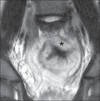Abdominal vascular syndromes: characteristic imaging findings
- PMID: 27777480
- PMCID: PMC5073393
- DOI: 10.1590/0100-3984.2015.0136
Abdominal vascular syndromes: characteristic imaging findings
Abstract
Abdominal vascular syndromes are rare diseases. Although such syndromes vary widely in terms of symptoms and etiologies, certain imaging findings are characteristic. Depending on their etiology, they can be categorized as congenital-including blue rubber bleb nevus syndrome, Klippel-Trenaunay syndrome, and hereditary hemorrhagic telangiectasia (Rendu-Osler-Weber syndrome)-or compressive-including "nutcracker" syndrome, median arcuate ligament syndrome, Cockett syndrome (also known as May-Thurner syndrome), and superior mesenteric artery syndrome. In this article, we aimed to illustrate imaging findings that are characteristic of these syndromes, through studies conducted at our institution, as well as to perform a brief review of the literature on this topic.
As síndromes vasculares abdominais englobam doenças raras, com sintomas e causas diversas, mas com achados de imagem característicos. Dividem-se em dois grupos distintos, a depender de sua origem, que pode ser congênita (síndrome de blue rubber bleb nevus, síndrome de Klippel-Trenaunay e telangiectasia hereditária hemorrágica/Rendu-Osler-Weber) ou compressiva (síndrome do "quebra-nozes", síndrome do ligamento arqueado, síndrome de Cockett ou May-Thurner e síndrome da artéria mesentérica superior). Neste artigo, o nosso objetivo é ilustrar achados de imagens determinantes dessas doenças, por meio de estudos adquiridos em nossa instituição, associando uma breve revisão da literatura.
Keywords: Arteriovenous fistula; Fístula arteriovenosa; Gastrointestinal tract; Hemangioma; Trato gastrintestinal; Trombose venosa; Venous thrombosis.
Figures














Similar articles
-
Congenital vascular lesions of the gastrointestinal tract: blue rubber bleb nevus and Klippel-Trenaunay syndromes.South Med J. 2001 Apr;94(4):405-10. South Med J. 2001. PMID: 11332907
-
Vascular disorders.Dermatol Clin. 1987 Jan;5(1):239-50. Dermatol Clin. 1987. PMID: 3030594 Review.
-
[Neurocutaneous syndromes with vascular alterations].Rev Neurol. 1997 Sep;25 Suppl 3:S250-8. Rev Neurol. 1997. PMID: 9273170 Review. Spanish.
-
Multiple vascular malformation in the "blue rubber bleb naevus" syndrome: a case with aneurysm of vein of Galen and vascular lesions suggesting a link to the Weber-Osler-Rendu syndrome.Histopathology. 1978 Jul;2(4):301-11. doi: 10.1111/j.1365-2559.1978.tb01722.x. Histopathology. 1978. PMID: 700606
-
Pulmonary arteriovenous fistula in the newborn: a case report of Rendu-Osler-Weber syndrome and a review of the literature.Turk J Pediatr. 2001 Oct-Dec;43(4):332-7. Turk J Pediatr. 2001. PMID: 11765165 Review.
Cited by
-
Acute superior mesenteric artery syndrome complicated by severe gastric, pancreatic and renal ischaemia.BMJ Case Rep. 2024 Feb 21;17(2):e259177. doi: 10.1136/bcr-2023-259177. BMJ Case Rep. 2024. PMID: 38383132
-
Compression of left renal vein and left common iliac vein on CT scans: how often are they detected?J Vasc Bras. 2020 Jun 1;19:e20190121. doi: 10.1590/1677-5449.190121. J Vasc Bras. 2020. PMID: 34178065 Free PMC article.
-
Dural fistula with bilateral arterial supply, mimicking a brainstem tumor.Radiol Bras. 2017 Jan-Feb;50(1):65. doi: 10.1590/0100-3984.2015.0186. Radiol Bras. 2017. PMID: 28298738 Free PMC article. No abstract available.
-
Wilkie's syndrome: a case report of favourable minimally invasive surgery.J Surg Case Rep. 2018 Feb 15;2018(2):rjy027. doi: 10.1093/jscr/rjy027. eCollection 2018 Feb. J Surg Case Rep. 2018. PMID: 29479421 Free PMC article.
-
Diagnosis and treatment of the Nutcracker syndrome: a review of the last 10 years.J Vasc Bras. 2018 Jul-Sep;17(3):220-228. doi: 10.1590/1677-5449.012417. J Vasc Bras. 2018. PMID: 30643508 Free PMC article. Review.
References
LinkOut - more resources
Full Text Sources
Other Literature Sources
Molecular Biology Databases
